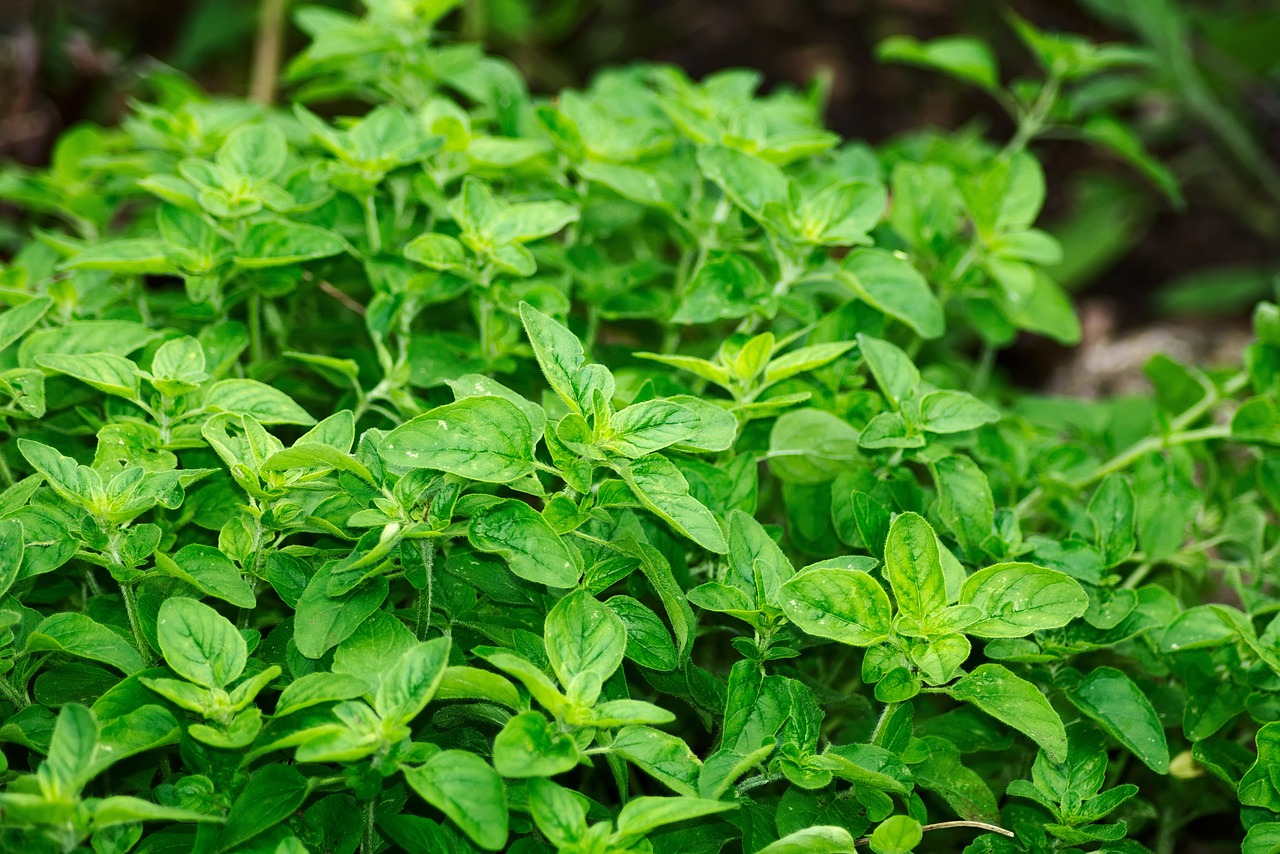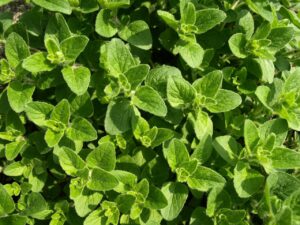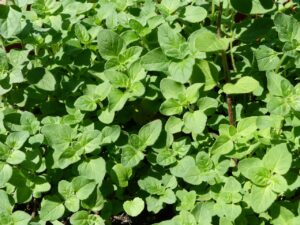Oregano
Overview
Oregano, a robust member of the mint family, flourishes in full sun and well-drained soils. Prized for its fragrant leaves, which enhance a myriad of culinary dishes, it also beckons butterflies to its showy summer blooms. This versatile plant is not just a kitchen staple—it’s also a charmer in the garden, easy to grow, and resilient against pests, though watchful care is needed to prevent excess moisture issues.

Characteristics
Known for its robust, woody stems, fragrant, peppery foliage, and attractive pinkish-purple or white flowers.
Region
Native to temperate Western and Southwestern Eurasia and the Mediterranean region.
Natural Habitat
Typically found in dry or rocky areas, including roadsides and open grasslands.
Cultivation
Prefers full sun, dry to medium moisture levels, and well-draining soil.
Uses and Benefits
Oregano, with its peppery, slightly bitter taste, is a staple in kitchens around the globe4. Fresh or dried, it imparts a zest that elevates dishes like:
- Pizza
- Pasta sauces
- Marinades for meats and vegetables
This herb isn’t just about flavor, though. It’s also celebrated for its potential health benefits, including its antibacterial and antioxidant properties1.
In the garden, oregano doubles as a charming ground cover, creating a sea of delicate blossoms that attract butterflies3 5. It’s partner-friendly, too, getting along well when planted next to:
- Ocimum basilicum (basil)
- Salvia rosmarinus (rosemary)
Plus, it’s easy to grow, making a forgiving addition for both novice and seasoned gardeners2.

Cultivation Tips
Growing your own oregano is a delightfully simple endeavor that rewards you with fragrant and flavorful leaves to elevate any dish. To ensure your oregano thrives, choose a sunny spot in your garden as these plants love basking in full sun. When it comes to watering, moderation is key since oregano doesn’t require much moisture to flourish5.
While oregano isn’t particularly picky about soil type, it does demand good drainage. Waterlogged soil can be detrimental to the plant’s health, potentially causing root rot2. To avoid this, make sure your planting area has adequate drainage or consider using raised beds.
If you’re working with limited space, container gardening is an excellent option for growing oregano. Just be sure to choose pots with ample drainage holes to prevent water from accumulating. Planting oregano alongside companions like basil or thyme not only creates a convenient herb corner but also adds a vibrant, butterfly-attracting element to your garden4.
When caring for your oregano plants, keep an eye out for common pests like aphids. However, oregano is generally quite resilient and can stand its ground against most pest issues2. By following these simple tips, you’ll be well on your way to cultivating a thriving oregano plant that’s ready to enhance your culinary adventures.
Seasonal Considerations
Oregano is a hardy herb that thrives in a variety of climates, but there are a few key seasonal considerations to keep in mind for optimal growth and flavor. In the spring, oregano plants will begin to sprout new growth after the last frost. This is the perfect time to plant new oregano or to divide and transplant existing plants to encourage healthy growth.
As summer arrives, oregano plants will be in full swing, producing an abundance of flavorful leaves. To encourage bushier growth and prevent flowering, pinch back the tips of the stems regularly. This will also help to keep the plant from becoming too woody. Oregano is relatively drought-tolerant, but it’s important to water deeply and regularly during extended periods of heat and dryness.
In the fall, oregano plants will begin to wind down as the days grow shorter and cooler. This is the ideal time to harvest and dry oregano leaves for use throughout the winter. Cut stems just above a leaf node, tie them in bundles, and hang them in a cool, dry place until the leaves are crisp. Store dried oregano in an airtight container away from light and heat.
Winter can be a challenging time for oregano plants, particularly in colder climates. If you live in an area with harsh winters, it’s best to protect your oregano plants by mulching heavily around the base of the plant or by bringing potted plants indoors. Oregano can also be grown indoors year-round, provided it receives plenty of bright, direct light1.
By understanding the seasonal needs of your oregano plants, you can ensure a bountiful harvest of flavorful leaves year after year.

Issues and Troubleshooting
While oregano plants are generally hardy and resilient in the herb garden, they’re not entirely immune to trouble. It’s important to keep a watchful eye out for sneaky pests like spider mites and aphids, which can quickly infest and feast on the fragrant foliage. If you notice these little critters making themselves at home, take prompt action to give your oregano the best chance to recover and thrive.
One of oregano’s biggest challenges is its aversion to “wet feet” – too much water can lead to root rot, a fungal issue that no gardener wants to deal with. To prevent this, ensure your oregano is planted in well-draining soil and be cautious not to overwater, especially if the soil appears soggy2. Here are some tips to help your oregano stay healthy and trouble-free:
- Regularly inspect your oregano for signs of pests or disease
- If you spot pests, treat the plant with a natural insecticide or try companion planting with pest-repelling herbs like basil or rosemary
- Ensure your oregano receives plenty of sunlight and air circulation to discourage fungal growth
- Water deeply but infrequently, allowing the soil to dry out between watering sessions
- Prune your oregano regularly to promote healthy growth and prevent overcrowding
By following these guidelines and staying vigilant, your oregano plants should thrive, rewarding you with an abundant supply of flavorful leaves to elevate your favorite dishes and add a touch of Mediterranean flair to your kitchen creations!
History and Folklore
Oregano, a member of the mint family, has a rich history intertwined with folklore that spans across ancient civilizations and centuries. The Greeks revered this herb, believing it to be a creation of the goddess Aphrodite, symbolizing joy and happiness. As such, it found a place in bridal wreaths and was thought to ward off evil spirits.
The Romans, who appreciated oregano for its culinary and medicinal properties, played a significant role in spreading its use across Europe and North Africa. During the Middle Ages, oregano was commonly used for medicinal purposes, including the practice of placing its leaves under pillows at night to encourage peaceful sleep and visions.
The tradition of using oregano for protective measures persisted through various cultures, with people employing it to safeguard against misfortune and negative energies. This belief in oregano’s protective qualities has endured over time, cementing its place in both culinary and spiritual practices across the world.
References
1. Oregano – Wikipedia, https://en.wikipedia.org/wiki/Oregano
2. How to Grow and Care for Oregano – The Spruce, https://www.thespruce.com/growing-oregano-plants-1402818
3. Oregano: Planting, Growing, and Harvesting Oregano Plants | The Old …, https://www.almanac.com/plant/oregano
4. Oregano: How to Grow, Dry, and Use This Herb – The Spruce, https://www.thespruce.com/herb-profile-oregano-1761786
5. Origanum vulgare – Plant Finder – Missouri Botanical Garden, https://www.missouribotanicalgarden.org/PlantFinder/PlantFinderDetails.aspx?taxonid=281411
Nicolas Duval
Nicolas is a passionate advocate for nature and the art of wildcrafting. His dedication shines through in Wildcraftia, a website he meticulously crafted to serve as a haven for nature enthusiasts worldwide. Driven by a deep appreciation for nature’s connection to humanity, Nicolas embarked on his journey in 2011 with SmokableHerbs, a platform showcasing his love for nature’s bounty. Building upon this foundation, he established Smokably, a thriving online store offering premium herbs and blends to a global audience.
